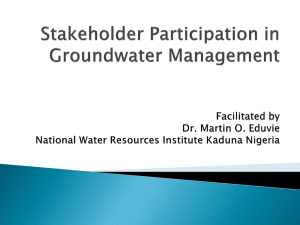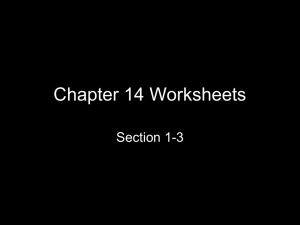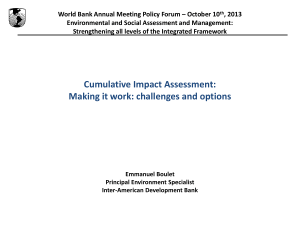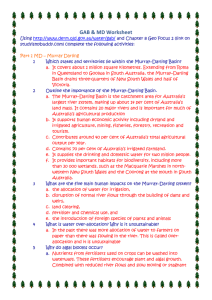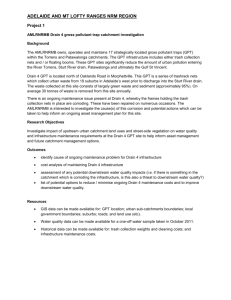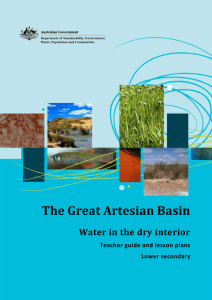Alpha Coal Mine IIESC Project Advice (DOCX
advertisement
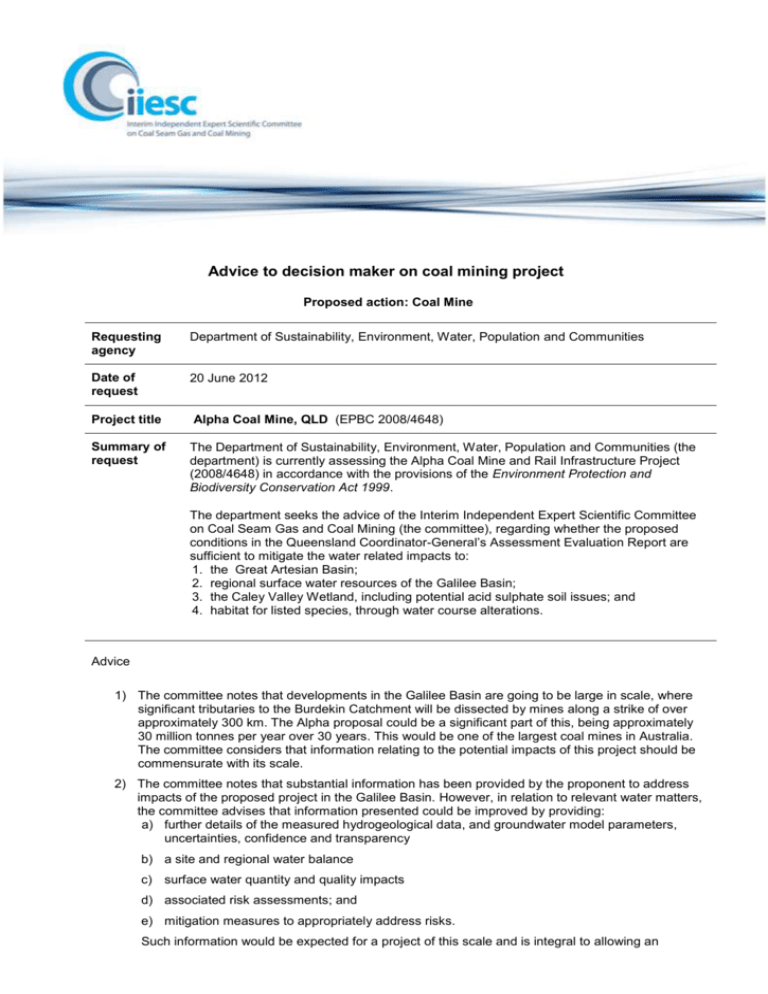
Advice to decision maker on coal mining project Proposed action: Coal Mine Requesting agency Department of Sustainability, Environment, Water, Population and Communities Date of request 20 June 2012 Project title Alpha Coal Mine, QLD (EPBC 2008/4648) Summary of request The Department of Sustainability, Environment, Water, Population and Communities (the department) is currently assessing the Alpha Coal Mine and Rail Infrastructure Project (2008/4648) in accordance with the provisions of the Environment Protection and Biodiversity Conservation Act 1999. The department seeks the advice of the Interim Independent Expert Scientific Committee on Coal Seam Gas and Coal Mining (the committee), regarding whether the proposed conditions in the Queensland Coordinator-General’s Assessment Evaluation Report are sufficient to mitigate the water related impacts to: 1. the Great Artesian Basin; 2. regional surface water resources of the Galilee Basin; 3. the Caley Valley Wetland, including potential acid sulphate soil issues; and 4. habitat for listed species, through water course alterations. Advice 1) The committee notes that developments in the Galilee Basin are going to be large in scale, where significant tributaries to the Burdekin Catchment will be dissected by mines along a strike of over approximately 300 km. The Alpha proposal could be a significant part of this, being approximately 30 million tonnes per year over 30 years. This would be one of the largest coal mines in Australia. The committee considers that information relating to the potential impacts of this project should be commensurate with its scale. 2) The committee notes that substantial information has been provided by the proponent to address impacts of the proposed project in the Galilee Basin. However, in relation to relevant water matters, the committee advises that information presented could be improved by providing: a) further details of the measured hydrogeological data, and groundwater model parameters, uncertainties, confidence and transparency b) a site and regional water balance c) surface water quantity and quality impacts d) associated risk assessments; and e) mitigation measures to appropriately address risks. Such information would be expected for a project of this scale and is integral to allowing an informed and robust scientific consideration of the project. 3) Given the pending development scenarios, the committee advises that the cumulative surface and groundwater impacts in the region have not been assessed. Based on the limited information presented, in particular, on cumulative impacts, the committee has considerable concerns relating to the scale and extent of impacts associated with the project. A regional cumulative impact assessment should be undertaken as a matter of priority. 4) The committee notes that an independent due diligence assessment has been undertaken on the proponent’s initial groundwater model report. The groundwater model report was revised based on this assessment. However, a regional water balance has not been provided to place the project in context. 5) The committee further recommends that the regional cumulative impacts (covering surface water, groundwater, geomorphological, hydrological and ecological impacts) be adequately assessed and appropriately influence the conditioning and management of the project development phases. 6) In terms of the specific advice requested, the committee notes that based on the information provided that: a) the proposed mine is in close proximity to the eastern margin of the Great Artesian Basin. The committee notes that there was not enough information to make an assessment as to the integrity of the Rewan Formation as an aquitard in this area to restrict connection with the Great Artesian Basin. In the absence of this assurance, it would be necessary to highlight the risks posed to the Great Artesian Basin from the current proposal, as well as future proposals. b) the region’s hydrology and water quality may be affected by the scale of the proposed projects significantly reducing the quantity of surface water in the region; acid water drainage, especially after water quality in the final void deteriorates; the diversion of Lagoon Creek; emergency discharges of contaminated water; leachate from the onsite landfill; and the use of overburden to backfill open-cut pits. As specific risks cannot be quantified without an adequate water balance, surface water cumulative impact study, or solute balance, it is difficult to assess the adequacy of mitigation measures to reduce impacts to an acceptable level, including acid water drainage which may impact on the water quality of the Burdekin Catchment. c) habitat for listed species will primarily be affected by the cumulative quantity of water intercepted in the catchment; acid water drainage; the diversion of Lagoon Creek; and the rail loop which intersects the Caley Valley Wetland. d) the proposed railway loop intersects a substantial portion of the Caley Valley Wetland. This has potential to significantly impact on the values of the wetland both directly through its location, and indirectly through changes to water quality resulting from changes in freshwater and tidal hydrology, and release of contaminants and oxidation of potential acid sulphate soils to the Wetland during and after construction. However, the proponent intends to offset their impact to the Wetland via land and financial (in-kind) contributions. The committee is not confident that the proposed offsets are sufficient, especially regarding the quality of offsets compared to cumulative impacts and outcomes sought. 7) In summary, the committee recommends that the Galilee Basin component of the wider Lake Eyre Basin bioregional assessment be conducted as a matter of priority, in order to assess regional cumulative impacts. Specifically, the bioregional assessment should include an assessment of groundwater impacts associated with the Galilee Basin (which may affect the Great Artesian Basin to the west), and surface water impacts associated with the Burdekin Catchment (which may be impacted to the east). Further, a regional and site water balance should be provided as baseline information, and a regional risk-based approach should be developed to examine local and regional impacts. Any proposed models should be peer reviewed and publicly released. Date of advice 20 July 2012 2
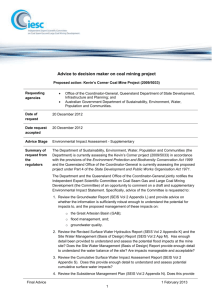
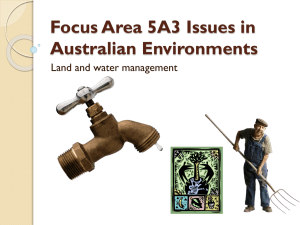


![Georgina Basin Factsheet [DOCX 1.4mb]](http://s3.studylib.net/store/data/006607361_1-8840af865700fceb4b28253415797ba7-300x300.png)

